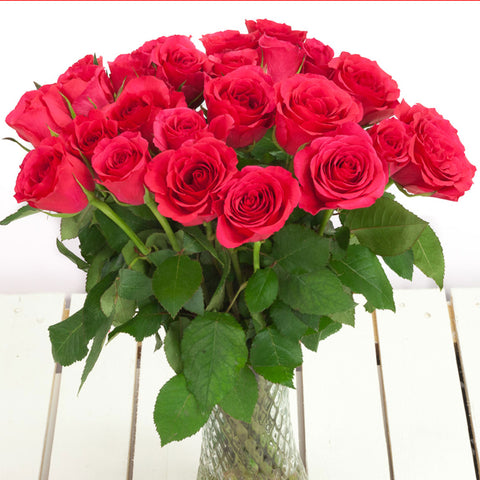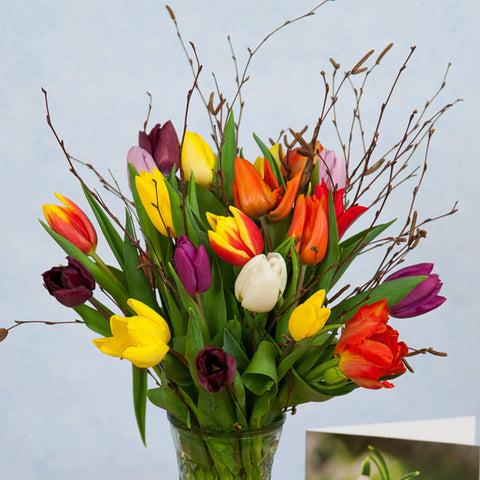Flower Facts & Meanings
National Flower Emblems of Britain
The Rose – This was adopted as England’s flower emblem during the Civil War (1455-1485), known as the War of the Roses. The Royal House of Lancaster being the red rose and the Royal House of York being the white. At the end of the war King Henry VII chose to combine both roses into a single red and white Tudor Rose.
The Thistle – was adopted as the emblem of Scotland during the reign of Alexander III (1249-1286). Legend has it that the army of King Haakon of Norway, intent on conquering the Scots, landing at night removed their footwear to allow them to move quietly onto the sleeping clansman. They are said to have stood on the spiny thistle and shrieked out, awakening the Scots who then won the day.
The Daffodil – the possible reason for this emblem to be used for Wales is that the words for Leek (the traditional welsh emblem) and daffodil in Welsh are the same – Cenhinen being Leek, and Cenhinen Pedr being Daffodil. Also it is thought that the wearing of a daffodil on St David’s Day is more preferred to the Leek.
The Shamrock – believed to be originally chosen as the emblem for Ireland by St Patrick who used the three leafed plant to show the doctrine of the Trinity, the Father, the Son and the Holy Spirit. The Shamrock has been considered by the Irish as a good luck symbol since earliest times.
Flowers and the Zodiac
It is believed that signs of the Zodiac have their own flowers, either depicting a strong colour or look that can be attributed to certain characteristics associated with the sign.
Aries – prickly pear, cockscomb, thorn-bearing shrubs, red roses, tulips, red peppers, amaryllis
Taurus – sweet william, scented stock, fruit-bearing trees, lavender, lilac, aster, lily of the valley, sweet pear
Gemini – winter cherries, ranunculus, maidenhair fern, solidago, acacia, daffodil, nut-bearing trees, cactus
Cancer – cornflowers, Queen Anne’s lace, delphinium, ferns, plumbago, passionflower, hydrangea, iris
Leo – croton, Joseph’s coat, marigold, gerbera, crocosmia, dahlia, clivia, sunflower
Virgo – monkshood, hypericum, chrysanthemum, eucalyptus, veronica, violet, ivy, thistle
Libra – chincherinchee, Moluccella, cymbidium orchids, gardenia, tea roses, tuberose, freesia, gladiolus
Scorpio – venus fly trap, alpinia, amaranthus, red hot poker, hibiscus, peony, cactus, anthurium
Sagittarius – foxtail lily, eustoma, liatris, carnation, crocus, muscri, berried plants, allium
Capricorn – statice, holly, African violet, ivy, philodendron, kentia palm, snowdrop, jasmine
Aquarius – eryngium, arum lily, bird of paradise, pitcher plant, banksia, protea, yucca, aloe
Pisces – Madonna lily, euphorbia marinata, Cyperus, stephanotis, jasmine, lilac, narcissus, gypsophila
Flowers for each month and their meanings:
There are many myths and meanings regarding flowers, some ideas are given below
| January | Flower: Meaning: |
White Carnation Pure; Deep Love, Good Luck |
| February | Flower: Meaning: |
Purple Violet Modesty, Virtue, Faithfulness |
| March | Flower: Meaning: |
Yellow Daffodil Love Me, Desire, The Sun Shines When I’m With You, Sympathy |
| April | Flower: Meaning: |
Pink Sweet Pea Goodbye, Blissful Pleasure, Thank You |
| May | Flower: Meaning: |
White Lily of the Valley Sweetness, Humility, Return to Happiness |
| June | Flower: Meaning: |
Red Rose Love, Respect, Beauty of Youth |
| July | Flower: Meaning: |
Pink Larkspur Fickleness |
| August | Flower: Meaning: |
Yellow Gladioli Give Me a Break, I’m Really Sincere |
| September | Flower: Meaning: |
Purple Aster Symbol of Love, Daintiness |
| October | Flower: Meaning: |
Orange Marigold Sacred Affection, Grief, Jealousy |
| November | Flower: Meaning: |
Yellow Chrysanthemum A Desolate Heart |
| December | Flower: Meaning: |
White Narcissus Formality, Stay as Sweet as you are |
Flower Facts
Rose (rosa)
Roses originated in China but are now cultivated from America to the Far East. They are now available in a variety of colours except blue and true black. Roses are one of the most popular and best know flower throughout the world.
Care tips: Limp roses can be revived by standing in deep warm water, do not bash the stems as this will prevent them drinking water, leave the thorns if possible as removal can cause wounds where bacteria can enter. Roses should last about a week.
Lily (lilium candidum)
The origins of the Lily is thought to be China in the Middle Ages. Some forms are highly scented particularly some Oriental lilies, whereas many of the Asiatic lilies, although highly coloured are without a scent.
Care Tips: It is recommended that the pollen stamens are removed as this will prolong the life of the flower. If pollen does get onto any fabric “dab off” with sticky tape – do not use water.
Orchids (orchis)
Most orchids are indigenous to tropical regions of the world such as Asia and South America. They offer a colourful selection including black and green. Orchids are actually the largest plant family offering over 25,000 species, the most common of which are the Phalaenopsis, Denrobium and Cymbidium.
Care Tips: Cut orchids can last 2-3 weeks, keep the water fresh and recut their stems, they also like a light misting of water.
Alstroemeria
The Alstroemeria is so named after Claus Alstroemer, a botanical classifier who sent seeds back from South America of this particular flower. They appear like miniature lilies with spot or stripe markings. Flower breeders have developed a huge range of varieties offering a vast array or colours and markings.
Care tips: the leaves will often wilt long before the flowers, so remove all foliage, the flowers should last about 2 weeks in water.
Carnation (dianthus)
The carnation is available all year round and offers a vast array of individual and multi-coloured flowers. They are available as a standard – being 1 flower per stem or as a spray which offers lots of smaller flowers per stem.
Care Tips: The carnation is a long lasting cut flower but should be kept away from any fruit or vegetables as they emit ethylene gas which will kill the flower.
Chrysanthemum
The “Mum” originates from China and Japan but the name derives from the Greek “krus anthemon” meaning gold flower, nowadays they are available in all colours from lime green to brick red. The flower comes in a large range of shapes and sizes including small buttons, spiky and large blooms.
Care Tips: Ideally cut at an angle with sharp scissors or break 2.3 cm from the bottom of the stem. Chrysanthemum normally last for up to three weeks, depending on the variety. Remove most of the foliage, as this tends to turn yellow quickly and replace the water weekly.
Gerbera
Pronounced Jur-bra, finds its origins in South Africa. There are over 200 varieties available offering a host of colours and different petal shapes. The mini gerbera or “germini” is quite a new development which still offers the variety of colours but are easier to use for flower arranging.
Care Tips: They love warmth and bright light. Cut 1.2 cm from the bottom of the stem. Always use fresh water and replace it regularly. They are sensitive to contaminate water which may lead to bent necks. If this occurs, cut an additional 2.3cm off the bottom of the stem and place into fresh water. They normally live for one to two weeks.
Gypsophila (baby’s breath)
The botanical name means “lover of chalk” – this is the soil it loves to grow in. The plant is native to Eastern Europe and was first commercially grown in UK around 1759. It is generally known as having a white flower although cream and pale pink are sometimes available.
Care Tips: Keep the water clean and the flowers should last a long time.
MEN and flowers
Men do love flowers, so don’t be shy. A recent survey showed over 60% of men questioned said they would like to receive flowers particularly on special occasions. Many men grow and admire the flowers they cultivate in their gardens so why wouldn’t they appreciate receiving some?
Everybody likes to be recognized and made to feel special – Men are no exception. Try to avoid pastel shades, stick to reds, yellows, orange and blues and try to avoid a fluffy design – stay with the more straight forward look.
Choosing the best time to send, especially for the first time can be tricky, Birthdays are an obvious choice of date, father's day or perhaps acknowledging a particular success at work.
Remember, just as women love receiving flowers for no reason at all, an out of the blue surprise floral gift will catch his attention too!
Flower trivia
- The World’s largest flower is the Titan Arum a native of central Sumatran rainforests. It is often referred to as the Corpse Flower due to its obnoxious smell. It grows to 3 metres in height.
- The World’s smallest flower is Wolffia, a type of duckweed found on the surface of ponds. Native to Australia and Malaysia its main body is no more than 0.9mm long and 0.5mm wide.
- The World’s oldest flowers were fossilized remains, thought to have flowered about 125 million years ago, in north-east China. It resembled the modern day water lily.
- Tulip bulbs can substitute the onion in cooking.
- Cats are attracted to sweet smells – so you will often see them smelling flowers.
- Broccoli is the only vegetable which is a flower.
- The poinsettia is the most commonly used plant at Christmas. It’s attraction is the red colour which are modified leaves called bracts, the flowers are actually yellow.
- Sunflowers can be used to soak up radiation.
- Rose Water was thought to successfully cure trembling, constipation, drunkenness, throat infections and insomnia.
- Lilies can be highly poisonous to cats.
- The World’s largest orchid can grow to 20 metres long.
- In Canada, a red carnation is worn if your mother is alive and a white one if she has died.
- Feng shui followers believe that the chrysanthemum brings laughter and happiness to the home.
- The Gerbera was little known about 20 years ago, but is now very fashionable.





